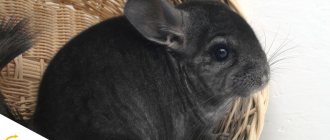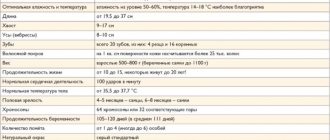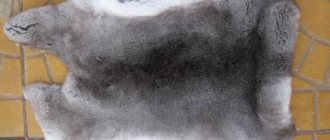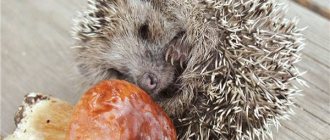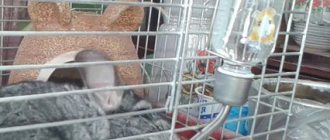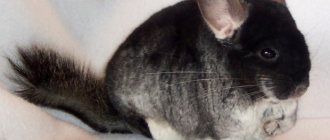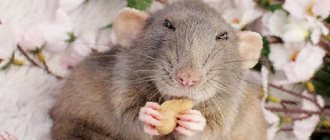The natural habitat of chinchillas is the highlands of the Andes, Peru, Bolivia, and Argentina. Because of their valuable fur, they became the target of constant hunting, which significantly reduced their numbers. For this reason, they were included in the International Red Book. However, this does not prevent you from turning chinchilla breeding into a successful business.
These fluffies are raised for fur in many countries. But in our country this type of activity has not yet gained wide popularity, which, in turn, provides little competition. This article will tell you how to start a business raising chinchillas.
Chinchilla breeding business – is it really possible to make money from it?
Making money from chinchillas primarily involves the production of valuable fur. In terms of cost, it is many times higher than other popular types of fur in our country. Due to the fact that the cultivation of these babies as a branch of industrial production has just begun to actively develop in our country, the demand for them significantly exceeds the supply.
High demand along with the lack of competition ensures the success of any enterprise. This means that chinchilla farming can safely be called an extremely profitable business.
A farmer I know indirectly confirmed the relevance of chinchilla farming.
According to his observations, 90% of Russian fur studios and specialized stores sell imported products. This dictates the broad sales prospects.
Every fashionable fur salon considers it its duty to offer chinchilla fur coats to the buyer. And high profitability, expressed in low cost and high income from its sale, will make you a constant and reliable partner of such stores.
To raise one male, you will need only a couple of hundred rubles, and the selling price of a 2-month-old animal varies from 3 to 15 thousand.
Hiring workers
Before breeding chinchillas at home, you need to decide on animal care staff. If it is only 3-5 families, you can cope with the task yourself. This will require 2-3 hours of free time. If you are planning a larger farm with 30-100 animals, you should hire a worker. His responsibilities will include:
- animal feeding;
- cleaning cells;
- renewal and ventilation of hygienic sand.
When hiring, you should give preference to those applicants who have experience interacting with animals. Employee salary is 20-25 thousand rubles.
Why are chinchillas bred?
For many ladies and their gentlemen, the word “chinchilla” is associated with the word “fur coat”. Of course, in most cases, representatives of this species are kept to obtain skins, but there are other areas of this business.
Among them are:
- breeding;
- meat production;
- as pets.
Breeding stock breeding
Offspring with favorable and pronounced characteristics primarily influence the success of the entire enterprise. Therefore, reproduction of a breed with the proper characteristics also becomes one of the sources of income.
When grading (evaluation based on a set of basic characteristics), the following are taken into account:
- the constitution;
- body type;
- state of the art;
- quality of fur.
After grading, the “successful” animal receives a pedigree. And animals with bad hereditary traits are culled, since good and productive offspring cannot be expected from them. On the contrary, by participating in mating, they will provoke a deterioration in subsequent livestock.
Meat and fur production
The main sources of income for any chinchilla farm are meat and fur.
Such products have a number of special advantages:
- Unlike other valuable rodents (arctic fox, sable, etc.), whose diet includes meat, chinchilla fur is odorless.
- Individuals do not require special attention. Experienced farmers even say: “You keep a rabbit, but sell a sable.”
- Meat is dietary. According to doctors, it helps in the treatment of sclerosis, tuberculosis and cancer.
- The skin is at least 250 times more valuable than rabbit fur. Due to the lack of shedding, she looks great at any time of the year.
For keeping as pets
Thanks to their aesthetic appearance, short six and good tolerance to allergy sufferers, keeping chinchillas as a pet is becoming a kind of trend.
On average, a chinchilla lives about 15 years. Therefore, unlike the case with parrots or ferrets, your child will not have to cry for a pet that has died of old age.
Chinchilla is a popular pet
Selecting a room
If you plan to breed chinchillas at home, then there are no great requirements for the premises. The cages can be placed in one of the rooms or in the attic of a private house.
If breeding for fur is planned, it is necessary to use a large room to house a large number of animals. Cages can be arranged not in one, but in 2-4 tiers, which allows for more efficient use of space.
One of the important requirements for keeping these rodents is maintaining optimal temperature. Chinchillas feel good at air temperatures of about +20 degrees.
To obtain better quality beautiful fur, the temperature is lowered to +10...+12 degrees. In such conditions, animals begin to adapt to the colder weather, and their fur becomes thicker. Such tricks only make sense if the rodents are raised on a fur farm.
However, experienced farmers do not advise novice breeders to do this. When the temperature drops, there is a risk of deterioration in the health of chinchillas and the development of diseases.
It is worth noting that chinchillas are relatively noisy animals. At the same time, they sleep during the day and are awake at night. Such features can become an obstacle to the breeding of rodents in the apartment. Experienced farmers advise renting a small room or ordering soundproofing for your apartment.
Why does this idea have a future?
Owners of fur farms have long appreciated all the benefits of growing chinchillas.
Let's name the main advantages of the business:
- Relatively little competition in Russia.
- Constant growth in demand for products.
- High profitability and quick payback.
- The opportunity to start practically from scratch, while spending a minimum of effort and money.
- Year-round production.
The number of fluffy ones increases relatively slowly - about 6 babies per female per year. The reproductive age is about 10 years, but if we take into account culling and loss due to natural causes, the net increase is small.
Based on the above, even according to the most optimistic estimates, it will take our country more than 40 years to achieve the world average for fur sales. This means that there will not be overproduction on the Russian fur market for a long time. That is, the chinchilla breeding business will definitely be in trend for another 10-20 years.
Paradox! One of the main reasons for the high profitability of such a business is the slow reproduction of animals.
Niche analysis
Chinchillas are fur-bearing animals that are highly valued in the commodity market. The fur of these rodents differs from the fur of most other animals in its high quality, beauty and softness. Such features can be explained by the unusual structure of the hair follicles. Thus, from the hair follicle of humans and many animals only one hair grows. In a chinchilla, up to 80 very fine soft hairs can develop from one bulb. This makes chinchilla fur in demand in the production of fur coats and hats.
In Russia, chinchilla breeding is a relatively free niche, so budding entrepreneurs have the opportunity to take their place. At the same time, it is important to prepare a detailed business plan, calculate expenses and income, and find sales points.
How to breed chinchillas for sale - detailed instructions
Anyone can organize their own profitable business with chinchillas. This does not require any serious investment in equipment or special education. All you need is a small, ventilated and warm room for a nursery (it’s possible to breed the first generations even in an apartment), farm cages and a good breeding stock.
Breeding chinchilla
For your information! Individuals with 12 or more points according to the Royal system are usually considered breeding.
Where to start, and what steps to take on the path to your success?
Step 1. Draw up a business plan
To open your first farm, you will need a relatively small room, about 1 square meter per 10 individuals (the cells are placed in several tiers on top of each other). We also need a utility room to store feed and care equipment. Don’t despair: utility bills will be minimal, because heating and lighting are needed at low levels. Our children eat dry food (it is advisable to purchase special food) and good quality hay. And let's not forget about the good bedding and staff. We carry out disinfection twice a year.
For those who do not want to delve into mathematical calculations, but want to find out how much they can earn and understand whether it will be profitable for them to breed chinchillas, we offer a ready-made business plan.
Step 2. Set up a place for breeding animals
Before you start buying individuals, you need to properly prepare and arrange a place to keep them.
Advice! In order not to run randomly throughout the farm, immediately think about how best (ergonomically) to arrange the cages.
This video will help you understand the cell structure:
The premises in which you plan to keep pets must meet the following requirements:
- Have sufficient lighting, but without direct sunlight (lamp) rays.
- Receive a constant flow of fresh air, but without drafts.
- Have humidity within 50-70%.
- The internal temperature should be 8-18°C.
- Have good sound insulation.
Special conditions are created for growing chinchillas indoors
Step 3. Buy animals and food
For successful breeding, and subsequently quick marketing, experienced farmers purchase breeding animals.
Visually they should be:
- healthy;
- active;
- young;
- with thick fur of the desired color (fur of dark tones is especially valued on the international market).
The nutrition of our clients deserves special attention. In the wild, the diet of rodents is not particularly diverse. They eat cereals and legumes, young shoots, moss and bark.
Important! Chinchillas have a very demanding digestive system. Therefore, unfamiliar foods can harm their health.
If you are afraid to create a diet yourself, buy ready-made industrial feed. They are developed taking into account all the needs of furry ones and contain key ingredients and trace elements.
Step 4. Register a business
For our business to be legal, it must be registered. Beginners can register a personal subsidiary plot and thus avoid tax deductions (except for land taxes). Gradually increasing sales, switch to individual entrepreneur status. To do this, we register with the Federal Tax Service and choose the type of taxation that is beneficial for us - the Unified National Economic Tax with a 6% rate of net income.
In our case, no special licenses or permits are needed; only 2 documents are required:
- certifying ownership of the farm;
- registration sheet from the local veterinary service.
Step 5. Advertise finished products and look for sales routes
The growth and expansion of production requires the search for new markets. After all, local restaurants and companies engaged in tanning skins will most likely no longer be able to cover our growing volumes with their purchases. We will have to look for new ways of sales.
Advertising will help with this:
- external (billboards, bulletin boards, etc.);
- Internet (specialized communities and forums);
- Mass media (local and regional publications on agricultural topics);
- TV (on channels about business and farming).
Idea! Do you want to quickly find those who buy both furs and meat? Operate through trading platforms such as OLKH.
To establish yourself as a chinchilla seller, an entrepreneur should regularly conduct advertising campaigns. There are several ways you can do this:
- print advertisements in the local newspaper;
- order advertising texts on radio and television;
- call pet stores - you can offer a discount for purchasing several animals;
- printing and distribution of advertising flyers on the street;
- writing advertising messages on thematic forums and city websites;
- maintaining an account on social networks;
- development and promotion of a business card website (you can hire a specialist to achieve this goal).
Particular attention should be paid to advertising at the very beginning of rodent breeding. This will require financial costs (printing leaflets, ordering advertisements, maintaining a website), but over time these investments will pay off.
Financial plan
Any successful business begins with a scrupulous study of the chosen business, analysis of the potential market and drawing up a financial plan. Thanks to him, the owner sees exactly what he should focus his attention on first and what he needs to prepare for.
We bring to your attention an example of such an analysis, designed to obtain the first litter of 40 individuals (10 females and 30 males) with one standard litter in six months (3 puppies):
| № | Expense item | Amount (thousand rubles) | Note |
| 1. | Equipment and tools | 23 | Cages, drinking bowls, baths, automatic feeders and other related equipment |
| 2. | Livestock | 120 | The cost of one breeding individual is about 3,000 rubles. |
| 3. | Rent | 60 | If you have your own premises, the costs are zero. |
| 4. | Major and current repairs | 15 | The main costs go to setting up lighting and ventilation |
| 5. | Nutrition | 20 | When preparing it yourself, the final cost is significantly lower. |
| 6. | Veterinarian remuneration | 10 | If you are self-employed, there is no need to pay for other hired labor |
| TOTAL: | 248 |
It turns out that without the need for subsequent purchases of individuals, our expenses will be about 248,000 - 120,000 = 128,000 rubles. for one generation. This means that with the sales price of one copy being 3,000 rubles. within 2.5-3 years, production fully pays for itself and begins to make a profit.
Expenses
To understand whether chinchilla breeding is profitable or not, you need to calculate the costs. For the first time, 20 individuals are enough, 16 of which will be females, 4 - males.
On average you will need:
- purchase of cells - 100 thousand rubles;
- rental of premises - about 40 thousand rubles. per month;
- animals (if there are no rodents in the farmer’s region of residence, delivery costs will be required) - 150 thousand rubles;
- feeders and drinking bowls - 20 thousand rubles;
- baths for dry bathing - 20 thousand rubles;
- food supply, vitamin supplements - 20 thousand rubles;
- hygienic sand - 10 thousand rubles;
- purchase and installation of an air conditioner - 30 thousand rubles;
- employee salary - 20 thousand rubles;
- paying taxes, visiting a veterinarian, unexpected expenses - 25 thousand rubles.
According to calculations, chinchilla breeding as a business requires initial costs of 440 thousand rubles.
Possible risks
Any business has its downsides and pitfalls. Chinchilla is no exception.
Let's consider the main risks that may arise on the path to success:
- Diseases. Although the risk of disease in the entire livestock is relatively small (chinchillas have strong immunity), there is always a danger of an epidemic due to errors in care and feeding.
- Poor quality young stock. There are many offers on the market for the sale of fluffy animals. Their prices range from $50 and up. And here lies the catch: it’s quite difficult to find quality specimens in Russia. And little-known farms offer animals that, despite their poor pedigree, are strongly reminiscent of breeding animals in appearance.
- Selection of feed. Nutrient mixtures offered by domestic manufacturers are not always of high quality: rabbit food is often sold under the guise of chinchilla food. Therefore, you will have to either supplement it with additives yourself, or buy expensive imported ones.
- Implementation. If you have not thought through in advance where you will sell the offspring, then problems with sales will arise immediately after the appearance of the first offspring.
Reviews
According to reviews, chinchilla breeding as a business can become a profitable activity if you approach the development of a business plan as responsibly as possible.
Experienced farmers advise reducing costs as much as possible in the initial stages. By refusing to hire an employee, you can save 20-25 thousand rubles. per month, which will speed up the payback of the project. Another way is to hire a part-time worker. In this case, you will have to do some of the work yourself.
Maximum savings are achieved if you use your own premises or find the cheapest one. There are no great requirements for the structure, but it is worth considering the presence of a water supply.
Is it profitable to open a chinchilla farm - expert opinion
We have already talked a lot about the chinchilla business. But how do things work in practice? Let's find out from our good friend Andrey (31 years old), who has been raising and selling fluffy animals for more than three years.
“My business started, as they say, out of the blue. I used to just be into rodents, so I decided to buy a family of chinchillas as pets. I gave away the first offspring to relatives. It was they who suggested that I contact a pet store and negotiate the sale of subsequent litters. And now, for the fourth year now, I have been seriously studying these cute creatures. Now I sell them to restaurants and fur salons.
There were almost never any problems with the content. Sales have been established for a long time. True, I had to hire an assistant: since childhood I have not been able to watch animals being killed. Today, the funds from their sale not only cover all the needs of the farm, but also allow me to live comfortably,” Andrey shared.
Buying feed
Proper balanced nutrition for chinchillas is an important requirement for the formation of beautiful fluffy fur.
The diet of rodents can include:
- specialized mixtures (feed) for chinchillas;
- hay (experienced breeders recommend dandelion hay);
- fresh vegetables and fruits;
- From time to time you can add a boiled egg to the grain mixture;
- vitamins to maintain healthy and soft fur (vitamins for chinchillas are not always available in pet stores, so they can be replaced with supplements for other rodents).
You can also make feed by mixing several components. The advantage of this option is good quality, but it requires additional labor.
Remember
- It is worth buying only breeding individuals.
- Before purchasing animals, create the conditions they need.
- Carefully study the composition of the feed, or better yet, prepare it yourself.
- Don't skimp on veterinarian services.
- Pay attention to advertising.
To reduce them to a minimum, create a detailed business plan or use ours. And remember - your own farm can please you not only with an abundance of beautiful fluffies, but also with a stable, ever-growing income!
(
3 ratings, average: 5.00 out of 5)
Sales market
It is possible to receive income from the farm only if the entrepreneur can establish uninterrupted trade in rodents. The circle of potential buyers should be identified even before you start breeding chinchillas.
The target audience of the chinchilla farm is:
- individual buyers - people who want to have a pet at home;
- pet stores that sell animals.
You can establish contacts with stores not only in your own, but also in neighboring cities. This will help expand your sales area and increase profits.
Personnel issue
The ease of breeding chinchillas is noted in the fact that the animals do not require the involvement of a large number of people in their care. One entrepreneur can handle all the responsibilities.
During the day, feeding, cleaning, and analysis of the general condition of the wards are carried out. At night there is video surveillance and the house is guarded.
The breeder must pay taxes and make required contributions after officially registering the activity.
A veterinarian is not registered as a staff member. It is necessary to conclude an agreement for the provision of services and invite a specialist as the services specified in the schedule are carried out.
